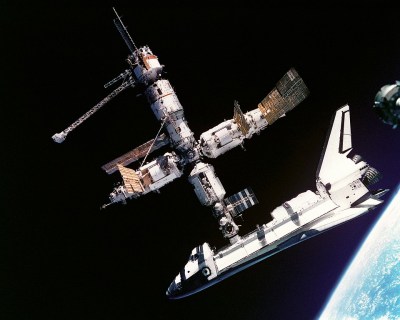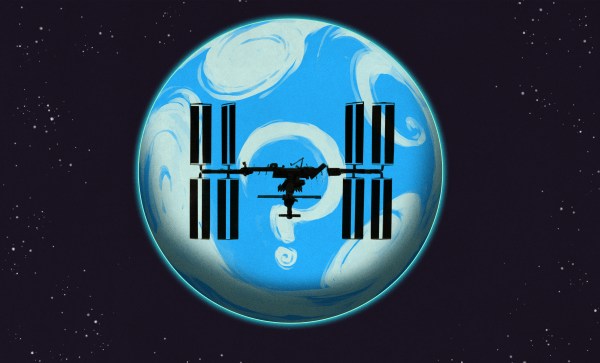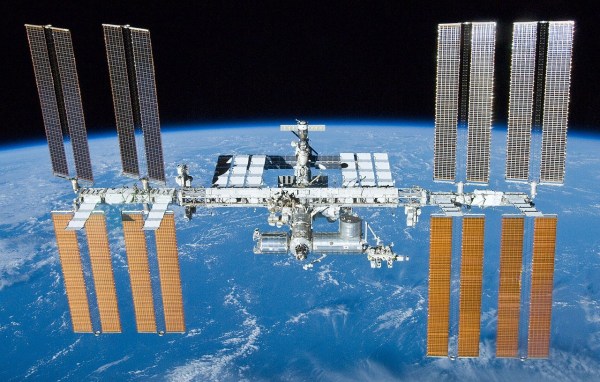It’s been a while since we heard from Dmitry Rogozin, the always-entertaining former director of Roscosmos, the Russian space agency. Not content with sending mixed messages about the future of the ISS amid the ongoing war in Ukraine, or attempting to hack a mothballed German space telescope back into action, Rogozin is now spouting off that the Apollo moon landings never happened. His doubts about NASA’s seminal accomplishment apparently started while he was still head of Roscosmos when he tasked a group with looking into the Apollo landings. Rogozin’s conclusion from the data his team came back with isn’t especially creative; whereas some Apollo deniers go to great lengths to find “scientific proof” that we were never there, Rogozin just concluded that because NASA hasn’t ever repeated the feat, it must never have happened.
roscosmos12 Articles
Hackaday Links: June 12, 2022
“Don’t worry, that’ll buff right out.” Alarming news this week as the James Webb Space Telescope team announced that a meteoroid had hit the space observatory’s massive primary mirror. While far from unexpected, the strike on mirror segment C3 (the sixth mirror from the top going clockwise, roughly in the “south southeast” position) that occurred back in late May was larger than any of the simulations or test strikes performed on Earth prior to launch. It was also not part of any known meteoroid storm in the telescope’s orbit; if it had been, controllers would have been able to maneuver the spacecraft to protect the gold-plated beryllium segments. The rogue space rock apparently did enough damage to be noticeable in the data coming back from the telescope and to require adjustment to the position of the mirror segment. While it certainly won’t be the last time this happens, it would have been nice to see one picture from Webb before it started accumulating hits.
Hackaday Links: May 8, 2022
Russia’s loose cannon of a space boss is sending mixed messages about the future of the International Space Station. Among the conflicting statements from Director-General Dmitry Rogozin, the Roscosmos version of Eric Cartman, is that “the decision has been made” to pull out of the ISS over international sanctions on Russia thanks to its war on Ukraine. But exactly when would this happen? Good question. Rogozin said the agency would honor its commitment to give a year’s notice before pulling out, which based on the current 2024 end-of-mission projections, means we might hear something definitive sometime next year. Then again, Rogozin also said last week that Roscosmos would be testing a one-orbit rendezvous technique with the ISS in 2023 or 2024; it currently takes a Soyuz about four orbits to catch up to the ISS. So which is it? Your guess is as good as anyones at this point.
At what point does falsifying test data on your products stop being a “pattern of malfeasance” and become just the company culture? Apparently, something other than the 40 years that Mitsubishi Electric has allegedly been doctoring test results on some of their transformers. The company has confessed to the testing issue, and also to “improper design” of the transformers, going back to the 1980s and covering about 40% of the roughly 8,400 transformers it made and shipped worldwide. The tests that were falsified were to see if the transformers could hold up thermally and withstand overvoltage conditions. The good news is, unless you’re a power systems engineer, these aren’t transformers you’d use in any of your designs — they’re multi-ton, multi-story beasts that run the grid. The bad news is, they’re the kind of transformers used to run the grid, so nobody’s stuff will work if one of these fails. There’s no indication whether any of the sketchy units have failed, but the company is “considering” contacting owners and making any repairs that are necessary.
For your viewing pleasure, you might want to catch the upcoming documentary series called “A League of Extraordinary Makers.” The five-part series seeks to explain the maker movement to the world, and features quite a few of the luminaries of our culture, including Anouk Wipprecht, Bunnie Huang, Jimmy DiResta, and the gang at Makers Asylum in Mumbai, which we assume would include Anool Mahidharia. It looks like the series will focus on the real-world impact of hacking, like the oxygen concentrators hacked up by Makers Asylum for COVID-19 response, and the influence the movement has had on the wider culture. Judging by the trailer below, it looks pretty interesting. Seems like it’ll be released on YouTube as well as other channels this weekend, so check it out.
But, if you’re looking for something to watch that doesn’t require as much commitment, you might want to check out this look at the crawler-transporter that NASA uses to move rockets to the launch pad. We’ve all probably seen these massive beasts before, moving at a snail’s pace along a gravel path with a couple of billion dollars worth of rocket stacked up and teetering precariously on top. What’s really cool is that these things are about as old as the Space Race itself, and still going strong. We suppose it’s easier to make a vehicle last almost 60 years when you only ever drive it at half a normal walking speed.
And finally, if you’re wondering what your outdoor cat gets up to when you’re not around — actually, strike that; it’s usually pretty obvious what they’ve been up to by the “presents” they bring home to you. But if you’re curious about the impact your murder floof is having on the local ecosystem, this Norwegian study of the “catscape” should be right up your alley. They GPS-tagged 92 outdoor cats — which they dryly but hilariously describe as “non-feral and food-subsidized” — and created maps of both the ranges of individual animals, plus a “population-level utilization distribution,” which we think is a euphemism for “kill zone.” Surprisingly, the population studied spent almost 80% of their time within 50 meters of home, which makes sense — after all, they know where those food subsidies are coming from.
One Giant Leap (Backwards) For Humankind: What The Russia-Ukraine War Means For The ISS
The International Space Station was built not only in the name of science and exploration, but as a symbol of unity. Five space agencies, some representing countries who had been bitter Cold War rivals hardly a decade before the ISS was launched, came together to build something out of a sci-fi novel: a home among the stars (well, in Low Earth Orbit) for humans from around the globe to work with one another for the sake of scientific advancement, high above the terrestrial politics that governed rock below. That was the idea, at least.
So far, while there has been considerable sound and fury in social media channels, international cooperation in space seems to continue unhindered. What are we to make of all this bluster, and what effects could it have on the actual ISS?
Hackaday Links: March 13, 2022
As Russia’s war on Ukraine drags on, its knock-on effects are being felt far beyond the eastern Europe theater. And perhaps nowhere is this more acutely felt than in the space launch industry, seeing that at least until recently, Russia was pretty much everyone’s go-to ride to orbit. All that has changed now, at least temporarily, and has expanded to include halting sales of rocket engines used in other nations’ launch vehicles. Specifically, Roscosmos has put an end to exports of the RD-180 engine used in the US Atlas V launch vehicle, along with the RD-181 thrusters found in the Antares rocket. The loss of these engines may be more symbolic than practical, at least for the RD-180 — United Launch Alliance stopped selling launches on Atlas V back last year, and had secured the engines it needed for the 29 flights it has booked by that April. Still, there’s some irony that the Atlas V, which started life as an ICBM aimed at the USSR in the 1950s, has lost its Russian-made engines.
Bad news for Jan Mrázek’s popular open-source parametric search utility which made JLCPCB’s component library easier to use. We wrote about it back in 2020, and things seemed to be going fine up until this week, when Jan got a take-down request for his service. When we first heard about this, we checked the application’s web page, which bore a big red banner that included what were apparently unpleasant accusations Jan had received, including the words “reptile” and “parasitic.” The banner is still there, but the text has changed to a more hopeful tone, noting that LCSC, the component supplier for JLC’s assembly service, objected to the way Jan was pulling component data, and that they are now working together on something that everyone can be happy with. Here’s hoping that the service is back in action again soon.
Good news, everyone: Epson is getting into the 3D printer business. Eager to add a dimension to the planar printing world they’ve mostly worked in, they’ve announced that they’ll be launching a direct-extrusion printer sometime soon. Aimed at the industrial market, the printer will use a “flat screw extruder,” which is supposed to be similar to what the company uses on its injection molding machines. We sure didn’t know Epson was in the injection molding market, so it’ll be interesting to see if expertise there results in innovation in 3D printing, especially if it trickles down to the consumer printing market. Just as long as they don’t try to DRM the pellets, of course.
You can’t judge a book by its cover, but it turns out that there’s a lot you can tell about a person’s genetics just by looking at their face. At least that’s according to an AI startup called FDNA, which makes an app called “Face2Gene” that the company claims can identify 300 genetic disorders by analyzing photos of someone’s face. Some genetic disorders, like Down Syndrome, leave easily recognizable facial features, but some changes are far more subtle and hard to recognize. We had heard of cases where photos of toddlers posted on social media were used to diagnose retinoblastoma, a rare cancer of the retina. But this is on another level entirely.
And finally, working in an Amazon warehouse has got to be a tough gig, and if some of the stories are to be believed, it borders on being a horror show. But one Amazonian recently shared a video that showed what it’s like to get trapped by his robotic coworkers. The warehouse employee somehow managed to get stuck in a maze created by Amazon’s pods, which are stacks of shelves that hold merchandise and are moved around the warehouse floor by what amounts to robotic pallet jacks. Apparently, the robots know enough to not collide with their meat-based colleagues, but not enough to not box them in. To be fair, the human eventually found a way out, but it was a long search and it seems like another pod could have moved into position to block the exit at any time. You could see it as a scary example of human-robot interaction gone awry, but we prefer to look at it as the robots giving their friend a little unscheduled break away from the prying eyes of his supervisor.
Hackaday Links: March 6, 2022
As if the war in Ukraine weren’t bad enough right here on Earth, it threatens knock-on effects that could be felt as far away as Mars. One victim of the deteriorating relationships between nations is the next phase of the ExoMars project, a joint ESA-Roscosmos mission that includes the Rosalind Franklin rover. The long-delayed mission was most recently set for launch in October 2022, but the ESA says that hitting the narrow launch window is now “very unlikely.” That’s a shame, since the orbital dynamics of Earth and Mars will mean that it’ll be 2024 before another Hohmann Transfer window opens. There are also going to be repercussions throughout the launch industry due to Russia pulling the Soyuz launch team out of the ESA’s spaceport in Guiana. And things have to be mighty tense aboard the ISS right about now, since the station requires periodic orbital boosting with Russian Progress rockets.
As ISS Enters Its Final Years, Politics Take Center Stage
There was a time when the idea of an international space station would have been seen as little more than fantasy. After all, the human spaceflight programs of the United States and the Soviet Union were started largely as a Cold War race to see which country would be the first to weaponize low Earth orbit and secure what military strategists believed would be the ultimate high ground. Those early rockets, not so far removed from intercontinental ballistic missiles (ICBMs), were fueled as much by competition as they were kerosene and liquid oxygen.

Luckily, cooler heads prevailed. The Soviet Almaz space stations might have carried a 23 mm cannon adapted from tail-gun of the Tu-22 bomber to ward off any American vehicles that got too close, but the weapon was never fired in anger. Eventually, the two countries even saw the advantage of working together. In 1975, a joint mission saw the final Apollo capsule dock with a Soyuz by way of a special adapter designed to make up for the dissimilar docking hardware used on the two spacecraft.
Relations further improved following the dissolution of the Soviet Union in 1991, with America’s Space Shuttle making nine trips to the Russian Mir space station between 1995 and 1997. A new era of cooperation had begun between the world’s preeminent space-fairing countries, and with the engineering lessons learned during the Shuttle-Mir program, engineers from both space agencies began laying the groundwork for what would eventually become the International Space Station.
Unfortunately after more than twenty years of continuous US and Russian occupation of the ISS, it seems like the cracks are finally starting to form in this tentative scientific alliance. With accusations flying over who should take the blame for a series of serious mishaps aboard the orbiting laboratory, the outlook for future international collaboration in Earth orbit and beyond hasn’t been this poor since the height of the Cold War.
Continue reading “As ISS Enters Its Final Years, Politics Take Center Stage”












